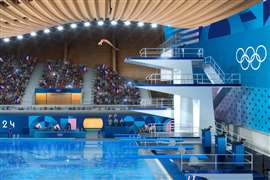The retrofit Olympics: Why LA 2028 won’t involve construction of any new sports venues
19 August 2024
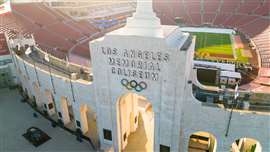 Los Angeles Memorial Coliseum (Image: Chad Robertson via AdobeStock - stock.adobe.com)
Los Angeles Memorial Coliseum (Image: Chad Robertson via AdobeStock - stock.adobe.com)
Throughout the Paris Olympics this summer and as they drew to a close earlier this month, much was made about the Games’ ‘lean’ approach, with 95% of the host sporting venues either existing or temporary structures.
But organisers of the next Olympic Games in Los Angeles in 2028 are looking to go one better.
Not a single new permanent venue will be constructed for LA28, in what marks an ongoing trend away from costly venues that risk becoming ‘white elephants’ once the Olympians and Paralympians pack up their medals and go home.
In fact, details released of the plan for the Games so far suggest that these will be the ‘retrofit Olympics’.
LA28, the private group organising the Olympic and Paralympic Games, named Autodesk as its official ‘design and make platform’ partner, earlier this month.
Autodesk’s software will support a $1 billion temporary overlay and construction plan to make more than 40 existing competition and non-competition venues suitable for hosting major international sporting events, in line with sustainable design principles. LA28 has an estimated budget of nearly $7 billion overall, which includes the cost of staging the events and the opening and closing ceremonies.
“At Autodesk, we believe the most sustainable building is the one already built,” says Amy Bunszel, executive vice president, architecture, engineering and construction solutions at Autodesk. “That’s why we’re excited by LA’s ambitious plan to retrofit existing structures to ensure sustainability is at the forefront of the LA28 Games venue plan. Over the next four years, our software will help set a new standard for creating a sporting event that intentionally designs, builds, repurposes and reuses existing venues.”
Explaining the decision, LA28 said retrofitting of existing buildings would emit less carbon than new construction, although it’s not clear at this stage how much less.
Retrofitting existing venues
Among the venues to be retrofitted will be the NFL’s largest venue, the SoFi Stadum in Inglewood, home to the Los Angeles Chargers and Rams. Having hosted the World Cup in 2026 and the Super Bowl in 2027, it will become the largest swimming venue in Olympic history capable of holding 40,000 fans, according to officials.
The plan involves building an Olympic-sized swimming pool in the middle of the stadium that can be covered with a decking system to host both the opening and closing ceremonies. It’s not clear at his stage how long the pool will remain after the Games but the plan is for it to be removed before the NFL season kicks off later in 2028.
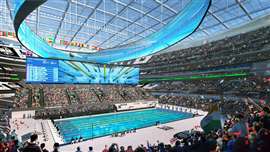 A 3D render of how the SoFi Stadium in Inglewood, California, could be adapted to host swimming events (Image courtesy of LA28)
A 3D render of how the SoFi Stadium in Inglewood, California, could be adapted to host swimming events (Image courtesy of LA28)
Meanwhile, there is a $54 million proposal to expand the Los Angeles Convention Centre, which is set to host boxing, fencing, taekwondo and table tennis competitions.
Work would involve adding 190,000 square feet (17,652 square metres) of exhibition space and 55,000 square feet (5,110 square metres) of meeting room space, with some existing buildings being connected. Another 95,000 square feet (8,826 square metres) of multipurpose space would also be added.
The Los Angeles City Council has already voted earlier this month to allocate funding to the project and move ahead with pre-construction work, which will determine whether the 1970s building can be adapted in time. Architect Populous and general contractors PCL and Webcor are involved in finalising the design plans, schedule and costs. If deemed feasible, construction work is due to start in spring 2025.
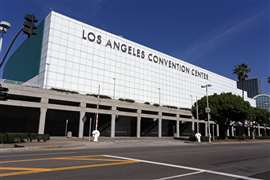 The Los Angeles Convention Center (Image: Katherine Welles via AdobeStock - stock.adobe.com)
The Los Angeles Convention Center (Image: Katherine Welles via AdobeStock - stock.adobe.com)
Other pre-existing venues are far older. The LA84 Foundation/John C Argue Swim Stadium originally hosted the 1932 Summer Olympics swimming events and in 2028 it will be the venue for diving competitions. Temporary stands are expected to be erected on two sides of the outdoor pool in 2028 to accommodate spectators.
The Los Angeles Memorial Coliseum will be used for track and field events, becoming the first stadium to have played host to the Olympics three times, having featured in the 1932 and 1984 LA Games.
One of the newest venues for the LA Games will be the Intuit Dome in Inglewood, home to the Los Angeles Clippers NBA team. It opened last week (15 August) and will, unsurprisingly, host basketball events.
Multi-billion-dollar transportation projects
Aside from the adaption of certain existing venues to suit the demands of the Games, other construction work is expected to arise in the form of transportation projects.
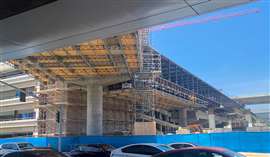 BrandSafway’s access solutions, including its patented QuikDeck Suspended Access System, are providing unimpeded vehicular and pedestrian passenger traffic during construction on the LAX project. (Photo: BrandSafway)
BrandSafway’s access solutions, including its patented QuikDeck Suspended Access System, are providing unimpeded vehicular and pedestrian passenger traffic during construction on the LAX project. (Photo: BrandSafway)
Los Angeles Mayor Karen Bass has previously announced that the city has secured nearly $80 million in federal funding to develop charging infrastructure for electric vehicles, as well as to pay for zero-emission buses.
The board of the LA Metropolitan Transportation Authority has approved 28 transportation projects totalling $20 billion, including upgrades to railway lines, electrification of bus routes, bus only lanes, and a bike path along the LA River. Originally, they were targeted for completion by 2028 and as things stand 18% are complete, 32% are under construction, 25% are in design and 25% are in planning.
The LA Metro board revised the list in March 2024, replacing projects that won’t meet the 2028 deadline. A full rundown of the status of the various projects is available here.
Meanwhile, Los Angeles Airport is in the final phase of a $14 billion modernisation programme that started back in 2009, with the modernisation of Terminals 4 and 5 approved last year. Meanwhile, the airports Automated People Mover (APM), running on 2.25 miles of elevated guideway connecting the Central Terminal Area, parking, Rent-A-Car, and Metro facilities will be ready to operate from 2026.
A more sustainable approach to the Games
The relatively frugal approach to venues planned by LA28 is in line with the International Olympic Committee’s (IOC) Olympic Agenda 2020+5 policy. It has urged organising committees to reduce the complexity and cost of the Games, including making use of existing facilities, even if some are outside of the host city.
In fact, this approach has been evolving for some time. While Paris 2024 took it further than previous editions of the Olympic and Paralympic Games, sports venue architecture specialist Populous, which has worked on every summer Olympics since 1996, points out that actually the approach started to shift with the Sydney 2000 Olympics.
There, the main Olympic stadium, now known as the Accor Stadium, was designed to accommodate 115,000 people during the Games before being reduced to a more sustainable capacity of 85,000 seats after the Olympics and Paralympics had concluded.
That concept moved on at the London 2012 Olympics, where many sports such as tennis, soccer, volleyball, rowing, canoeing, archery, badminton, boxing, fencing and weightlifting took place in existing venues. Others were hosted at temporary facilities and only a few new buildings were constructed, including the main stadium, which was downsized before becoming the permanent home of West Ham United FC.
At Paris 2024, the approach evolved once again. “The venue concept ensures sustainable legacies and reflects a strong commitment to minimising environmental impact,” says Francois Clement, senior principal at Populous and president of the practice’s French operation. “More than 70% of the venues are existing facilities, and a further 25% are temporary.”
As environmental excellence director for Paris 2024 Georgina Grenon said, “The single most important decision we have made is not to build.”
The LA Games are set to be a continuation of that trend and where new work for construction companies on Olympic venues comes, it will be in the form of retrofit and adaption, rather than construction from the ground up.


